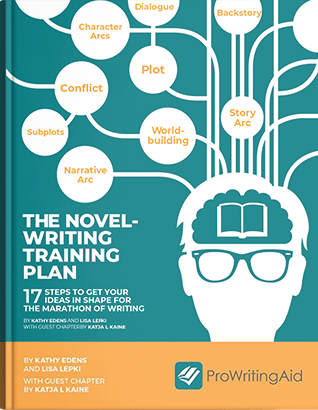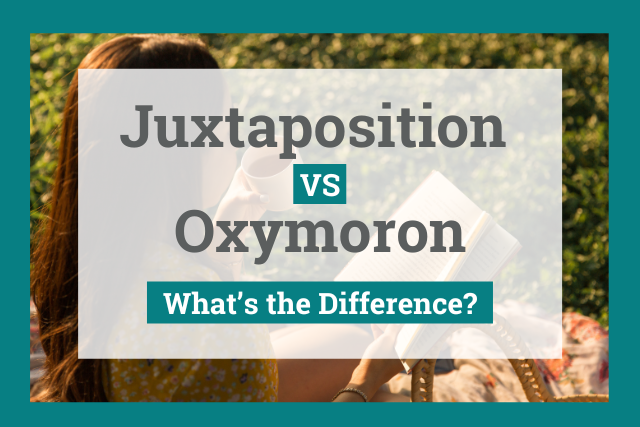
Juxtaposition and oxymoron are two literary devices that are easy to confuse. They both involve using two contradictory elements.
So, what's the difference between juxtaposition and oxymoron?
Juxtaposition involves writing about two elements, whether concepts or phrases, to emphasize a comparison or a contrast. They often represent a larger theme.
Oxymoron, on the other hand, is an apparently self-contradictory statement.
Let's take a closer look at juxtaposition and oxymoron.
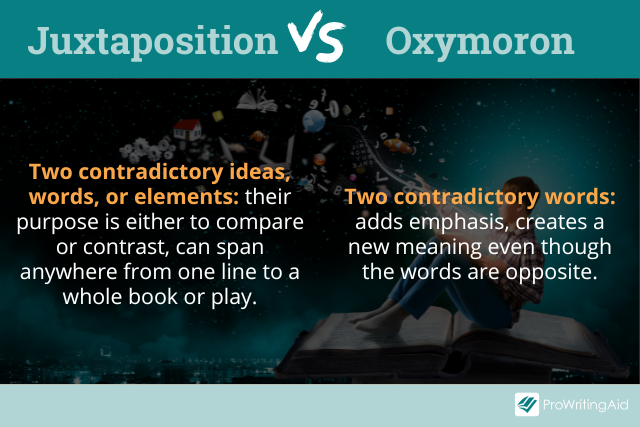
Quick Definition and Meaning of Juxtaposition
Writers use juxtaposition to either compare or contrast ideas. It's a way to emphasize two things that are either more similar than they appear or different in a substantial way.
Juxtaposition can appear in two different ways in writing.
Often, it involves two opposite concepts that are explored throughout an entire work. These can be recurring symbols, motifs, or extended metaphors.
Some commonly juxtaposed concepts in literature are light vs dark, good vs evil, and wealth vs poverty.
A great example of this type of juxtaposition is from F. Scott Fitzgerald's The Great Gatsby. East Egg is where people who come from rich families or "old wealth" live.
West Egg is where the "new wealth" people live. These neighborhoods juxtapose the societal difference between new wealth and old wealth.
Juxtaposition can also be used within single sentences. This involves placing contradictory terms together to either compare or contrast them.
One of the best examples of this is the opening line of Charles Dickens' A Tale of Two Cities:
"It was the best of times, it was the worst of times, it was the age of wisdom, it was the age of foolishness, it was the epoch of belief, it was the epoch of incredulity, it was the season of Light, it was the season of Darkness, it was the spring of hope, it was the winter of despair, we had everything before us, we had nothing before us, we were all going direct to Heaven, we were all going direct the other way..."
Dickens juxtaposes many ideas to set the tone of the book: best vs worst, wisdom vs foolishness, etc. He also juxtaposes Paris and London, as well as freedom and imprisonment, throughout the book.
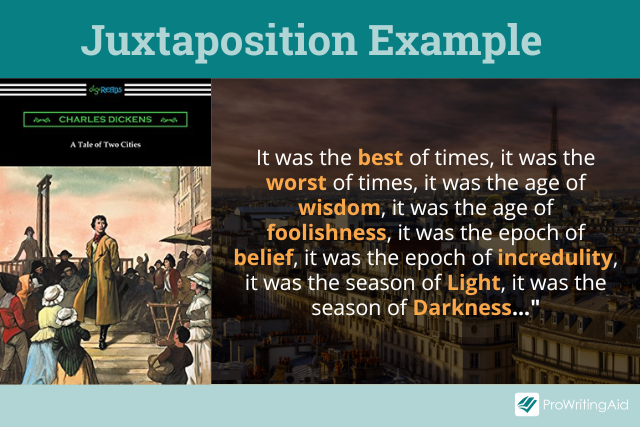
Quick Definition and Meaning of Oxymoron
An oxymoron is a rhetorical device that involves placing two words that appear to be complete opposites next to each other. In doing so, these two words create a new meaning.
Oxymorons can add emphasis, aid in description, add irony, or just be entertaining word play.
Here are some examples of oxymoron:
- Deafening silence
- Cold fire
- Serious vanity
- Jumbo shrimp
- Magical realism
- Passive aggressive
- Student teacher
- Freezer burn
- Close distance
- Exact estimate
You can probably see that you use oxymorons in your everyday life. But as a literary device, a deliberate and unique oxymoron can add poignancy to your writing.
One well-known example of oxymoron comes from Romeo and Juliet by William Shakespeare.
In the famous balcony scene, Romeo says, "parting is such sweet sorrow." Sorrow, by definition, is not sweet. But when this antagonistic expression is put together, we understand that there is beauty and emotion in the goodbye.
Sometimes an oxymoron is a figure of speech that has become too common, like the oxymoron “blue blood.” Clichés are overused figures of speech that can make your writing sound trite.
You can use ProWritingAid's Cliché Report to identify overused phrases, so you can find a fresh way to express the same idea.
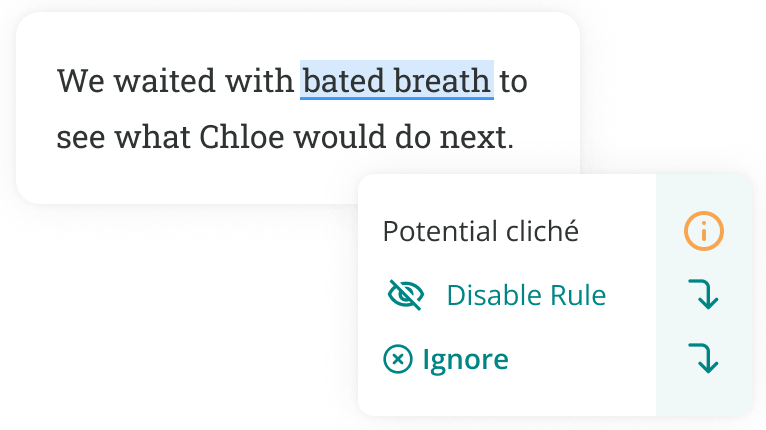
What's the Difference Between Juxtaposition and Oxymoron?
The major difference between juxtaposition and oxymoron lies in their purposes.
Juxtaposition is designed to compare or contrast, while oxymorons are a type of word play that either create a new phrase or emphasize a point using two elements.
Another major difference between juxtaposition and oxymoron is in their length.
As we saw in the examples above, juxtaposition can span a few words or an entire book, depending on what the contrasted objects are.
It doesn't have to be a single statement like oxymorons, which are only two words.
Oxymorons are about word play, whereas juxtaposition is a way to illuminate complex ideas.
Conclusion on Oxymoron vs Juxtaposition
Both oxymoron and juxtaposition are powerful literary devices. They both involve using contradicting elements, but their purposes are different.
Understanding them will help you add extra emphasis and poignancy to your writing.

